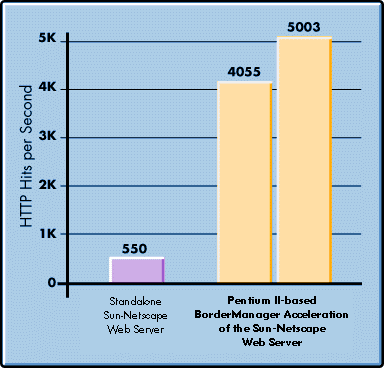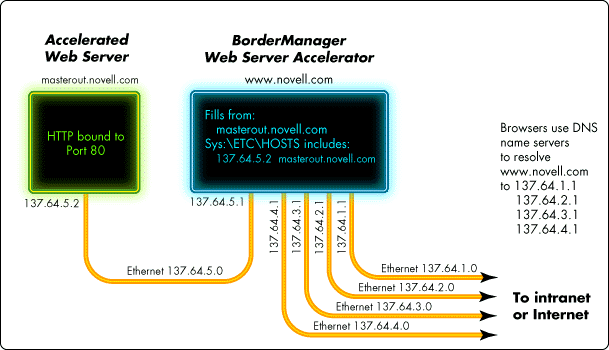PERFORMANCE REPORT
Articles and Tips: article
Senior Consultant
Systems Research Department
01 Jan 1998
Improving Sun Web Server Performance and Scalability with BorderManager Web Server Acceleration
Summary
A dual-processor 167MHz Sun Ultra Enterprise 3000 server running Netscape Enterprise Server lacks sufficient performance and scalability to keep up with the rapid pace of intranet and Internet growth. Using Novell's BorderManager web server acceleration running on an inexpensive Intel-architecture server platform, you can improve the scalability of your Sun web server by nearly 10 times.
Figure 1 compares the performance of a standalone dual-processor Sun Ultra Enterprise 3000 running Netscape Enterprise Server to the performance of the same Sun web server operating in concert with a BorderManager web server accelerator. The first accelerated result (4055 hits per second or hps) was produced on an Intel MB440LX DP Server Platform (266MHz Pentium II processor with 512MB SDRAM, 512KB L2 cache, 12GB Ultrawide SCSI storage) running IntranetWare 4.11 and BorderManager 1.0 web server accelerator. The second accelerated result (5003 hps) was produced on the same platform with a BorderManager performance enhancement that will be available in the Spring of 1998.
Figure 1: Web server acceleration achieved by adding a Pentium II processor-based BorderManager server dramatically improves system scalability beyond the standalone performance of the Sun-Netscape web server.

These tests were conducted in Novell's 1700-computer Superlab facility in Provo, Utah. (For more information about the SuperLab, visit http://yes.novell.com/devres/slab/.)
Analysis
The goal of these tests was to measure the performance improvement that BorderManager's web server acceleration brings to a combined Sun-Netscape web infrastructure. The results of these tests provide an overwhelming case for web server acceleration.
The Sun-Netscape solution is one of the most popular web publishing systems in the world. However, neither Sun's Solaris operating system nor Netscape's web server software were designed to take advantage of efficient caching technologies to deliver high-performance response times. Nor do they scale well enough to handle both "flash crowds"--the frequent spikes in user requests that typify today's web server workloads--and the incredible demand for intranet and Internet services that doubles every six months. The result is that customers who invest in the Sun-Netscape solution are plagued with performance problems that require additional hardware in the form of frequent upgrades, entire server replacements, and multi-server site configurations.
The good news for Sun and Netscape customers is that Novell provides an inexpensive solution to their performance woes that doesn't require them to replace their existing web publishing system. Operating as a web server accelerator in concert with the Sun-Netscape web server, Novell's BorderManager is a transparent network appliance that offloads 100% of the web server's direct connections to the user community. This configuration augments the web server's communications channel with BorderManager's cached performance, its 5000 hits-per-second capacity, and its ability to easily handle 100,000 active connections. In fact, the results of our tests show a uniprocessor Intel system outperforming a dual-processor Sun system by nearly ten to one.
Application to Real-World Systems
Test results generated in a lab environment, such as Novell's Superlab, often require some interpretation before they can be applied directly to real-world systems. If your real-world workload is similar to our test workload, you can use these results with little change. However, our results demonstrate peak performance; your results will vary depending on your production workload characteristics.
In the case that your site's content is static and its characteristics are similar to WebBench's data set consisting of 100 files for a total of 2.5 MB, you can apply these tests results directly to your web site without modification. Static content consists of HyperText Markup Language (HTML) files, graphics files, sound, or video. All static content is cacheable and therefore benefits from web server acceleration as demonstrated by these test results. When caching a static site, nearly 100% of the web server's workload is offloaded by the accelerator. (A 100% workload reduction is impossible due to frequent freshness checks and updates of expired cache content.) This workload transition from the web server to the accelerator can buy you years of additional service for a web server that was previously incapable of keeping up with demand.
Although static content makes up 90 to 100 percent of web content, webmasters at many sites allow requests for dynamically-generated content. These dynamic requests, which make up five to ten percent of all requests, are HTTP requests that reference programs, including CGI scripts, NSAPI scripts, ISAPI scripts, or PERL scripts. Because these dynamic requests must be handled by the web server, the accelerator passes them through to the web server. If you provide dynamically-generated content at your site, these pass-through requests will not benefit from acceleration directly. However, many of these dynamic requests eventually take advantage of the accelerator's caching because they refer to static content. Responses to these dynamic requests contain references to multiple static elements that must be requested by the browser before the transaction is complete. Once the browser receives the dynamic response, the browser begins requesting the rest of the page's static elements, which are cached by the BorderManager web server accelerator. In this scenario, you can apply the results of these tests indirectly to your web site, because although a portion of your site's content may be dynamic, the majority of content that is pushed out to the user community will be static and therefore cacheable. For example, on a site whose working set is 95% static and 5% dynamic--the typical mix--95% of the traffic will benefit from an accelerator's cached performance, as demonstrated by these test results.
Test Workload
We chose Ziff-Davis' WebBench because, like Novell's PERFORM3, it isolates the BorderManager communication channel between server cache and clients--the LAN infrastructure, server LAN adapters, server PCI expansion bus, and server cache. WebBench results provide a clear measure of BorderManager's peak communication channel performance capabilities and scalability. The WebBench workload we used was ZD_STATIC_V11.TST which uses a working data set of 100 files (2.5 MB).
Test Configuration
The system under test, a Novell BorderManager server, was an Intel MB440LX DP Server Platform (266MHz Pentium II processor with 512KB L1 cache, 1MB L2 cache, 512MB SDRAM, 12GB Ultrawide SCSI storage) running IntranetWare 4.11 and BorderManager 1.0. Commercial servers based on this Intel server platform are available from many server manufacturers.
This system was configured as a web server accelerator and contained five Intel EtherExpress PRO/100 Server Adapters (see Figure 2). Four of the adapters hosted IP subnets, each with nine Pentium Pro clients running Windows NT Workstation 4.0; the fifth adapter hosted a subnet connecting the web server accelerator to the web server and WebBench controller.
Figure 2: With five Intel EtherExpress PRO/100 Server Adapters operating in polled-mode (without interrupts), high-end Intel- architecture servers with four public interfaces can scale to over 40 Mbps throughput.

The LAN included five Bay Networks Fast Ethernet hubs, with the Novell BorderManager server acting as router between the four client subnets and the web server and controller on the fifth subnet.
The Sun web server was a Sun Ultra Enterprise 3000 with dual 167MHz UltraSPARC processors, 32KB L1 cache, 512KB L2 cache, 320MB RAM, 1 Seagate ST15230w 4.2Gb drive, and two Fast Ethernet LAN adapters, running SunOS 5.5.1, Solaris Internet Server Supplement 1.0, and Netscape Enterprise Server 3.0.
Copyright © 1997 by Novell, Inc. All rights reserved. No part of this document may be reproduced or transmitted in any form or by any means, electronic or mechanical, including photocopying and recording, for any purpose without the express written permission of Novell.
All product names mentioned are trademarks of their respective companies or distributors.
* Originally published in Novell AppNotes
Disclaimer
The origin of this information may be internal or external to Novell. While Novell makes all reasonable efforts to verify this information, Novell does not make explicit or implied claims to its validity.